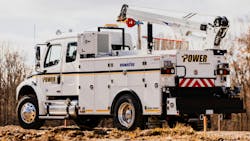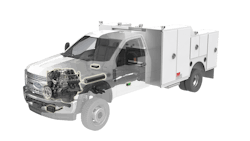How to Spec Service Truck Air and Welders
More on field service
- App offers "Uber for Techs."
- Non-CDL equipment elevates field maintenance.
- How to maintain DEF quality.
Key Takeaways
- Learn how to choose maintenance equipment for a field service truck.
- See how equipment choices maximize truck space.
When spec’ing a field maintenance truck, an equipment manager may assume that more power is better. In a perfect world, where budgets and truck size constraints never exist, that instinct is pretty spot on. But in the real world, an equipment manager’s job is to right-size equipment to the work that that technician needs to do in the field.
With respect to welding equipment, a basic service truck can likely function with something in the 200- to 250-amp range. Heavier-duty welding tasks, such as gouging, may require 300-plus amps.
With respect to the air compressor, proper spec’ing starts with airflow. For the typical service truck, 30-40 cfm will often be adequate since most common pneumatic tools require less than 40. There may be instances, however, where more airflow is needed, such as when running higher-cfm tools for higher duty-cycle applications, such as 1-inch impact wrenches for off-road-tire service.
“One of the best ways to determine your true air power needs is to simply look up the requirements of the specific tools being used,” says Mike Pettigrew, marketing manager at VMAC. “Equipment managers should calculate the total cfm their tools demand during simultaneous operation.”
Pressure ratings should also be considered. Pettigrew says most tools and air compressors operate optimally between 90 and 125 psi. “If you require constant pressure, it’s critical to upgrade to a rotary screw air compressor that can maintain cfm and psi for significant periods of time,” he says.
Equipment managers should also considier the environment in which a maintenance truck will operate. A technician working in extreme heat will benefit from a hydraulically driven model with advanced cooling capabilities. In extreme cold, look for built-in climate protection features. Options such as the factory-installed cold climate kit VMAC offers can also provide value.
Maximize service truck space requirements
Also consider space constraints on the truck. Air compressor systems that install under the engine hood, such as VMAC’s Underhood 70, are lighter and help free up space on the truck deck or cargo area.
A technician’s need for storage space was a big driving force behind one of Miller Electric’s latest product introductions.
“Technicians are inclined to want to take everything with them into the field because they need to get their job done quickly and efficiently,” says Andy Baus, product manager for work truck solutions at Miller Electric. “Overloading a truck is hard on the chassis and body. There are also limitations with respect to gross vehicle weight. If a technician is not a CDL driver, the fleet manager may have to start thinking outside the box and move into a smaller truck platform. That will likely mean less space for the technician to bring all that equipment with them.”
All-in-one solutions can help solve that problem. Instead of having a separate hydraulically driven compressor and bolt-on welder/generator, an all-in-one solution brings all essential functions into a lighter and more compact package.
Miller’s HDI Air Pak Series is one example. The HDI stands for hydraulically driven and integrated, meaning that everything ties into the truck’s hydraulic system. Baus says this streamlined package helps minimize equipment footprint by half, and reduces weight by as much as 400 to 500 pounds.
HDI Air Pak models are equipped with a rotary screw air compressor, multi-process welder, battery charger/crank assist, and auxiliary power. Baus says each model was designed to help fleet managers right-size critical performance specs for typical service truck needs. These all-in-one machines deliver 40 or 58 CFM at 100 psi, and 265 or 325 amps of output for stick or TIG welding. The Model 265 requires 11 gpm hydraulic flow from the chassis PTO system, making it a good fit for a Class 5 chassis. The Model 325 requires 16 gpm, making it a good fit for Class 6-8.
VMAC also offers all-in-one solutions. Its 6-In-1 Multifunction Power System includes a 45-cfm rotary screw air compressor and 250-amp welder.
Choosing between some kind of multi-function system and a more traditional multi-piece platform ultimately comes down to the type of truck the fleet wants to build out, along with the type of work the technician will be engaged in on a regular basis. With a complete understanding of both of those components, an equipment manager can spec smarter, helping drive technician efficiency while keeping capital costs in check.

